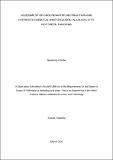| dc.contributor.author | Chacha, Nyamboge | |
| dc.date.accessioned | 2020-10-06T10:47:01Z | |
| dc.date.available | 2020-10-06T10:47:01Z | |
| dc.date.issued | 2020-03 | |
| dc.identifier.uri | https://doi.org/10.58694/20.500.12479/954 | |
| dc.description | A Dissertation Submitted in Partial Fulfilment of the Requirements for the Degree of
Doctor of Philosophy in Hydrology and Water Resources Engineering of the Nelson
Mandela African Institution of Science and Technology | en_US |
| dc.description.abstract | In this work geological and hydrogeochemical data, radioisotopes and stable isotopes, and
groundwater hydrographs were used to assess the groundwater abstraction trends and
hydrogeochemical characteristics of Arusha wellfield in Arusha city. Groundwater salinity in
terms of conductivity (EC) was also used to delineate salinity occurrence and distribution in
different parts of Tanzania including Arusha where this study was carried out. The
hydrogeochemical results revealed Na-K-HCO
3
water type. Water-rock interaction seems to
be the main process determining the groundwater chemistry in the study area. The analysis
of geological sections showed two potential aquifers, volcanic sediment and
weathered/fractured both of which yield water with high fluoride. Eighty two (82) percent of
the analyzed groundwater samples indicated fluoride concentrations higher than WHO
guidelines and Tanzanian drinking water standards (1.5 mg/l). Groundwater hydrographs
indicated significant groundwater depletion. Water level decline of about 1.0 m/year and
discharges reduction of 10 to 57% were observed from the year 2000 to 2017. The
radiocarbon isotope signatures showed that groundwater with mean age of 1400 years BP to
modern was being abstracted from the wellfield. Recently recharged water was also
evidenced by high
14
C activities (98.1±7.9 pMC) observed in spring water. Both groundwater
hydrographs and isotope signatures suggest that the Arusha wellfield is already stressed due
to groundwater over-abstraction. Through groundwater salinity mapping, it was revealed that
generally Arusha has fresh groundwater but with relatively high electric conductivity (10002000
µS/cm). The high salinity levels are partly due to dissolution of trona (evaporate
mineral) commonly found in the East African Rift System. It was further revealed that lack of
reliable hydrogeological information including interaction between surface water and
groundwater hinders water resources management efforts particularly issuance of water use
permit. Based on the findings of this study, it is recommended to carry out groundwater flow
patterns modelling to show how unregulated drilling affects the deep wells currently
depletion problem. | en_US |
| dc.language.iso | en | en_US |
| dc.publisher | NM-AIST | en_US |
| dc.rights | Attribution-NonCommercial-ShareAlike 4.0 International | * |
| dc.rights.uri | http://creativecommons.org/licenses/by-nc-sa/4.0/ | * |
| dc.subject | Research Subject Categories::NATURAL SCIENCES | en_US |
| dc.title | Assessment of groundwater abstraction and hydrogeochemical investigation in Arusha city, northern Tanzania | en_US |
| dc.type | Article | en_US |


